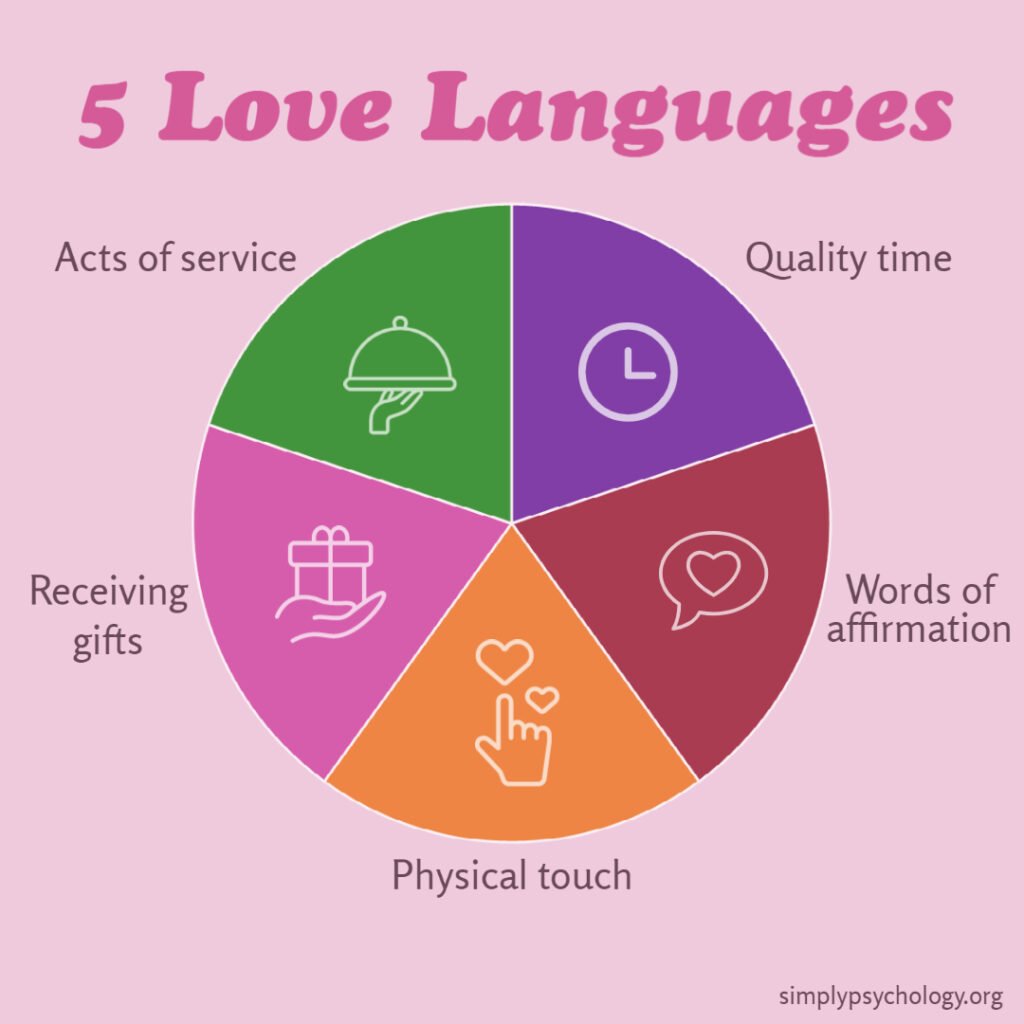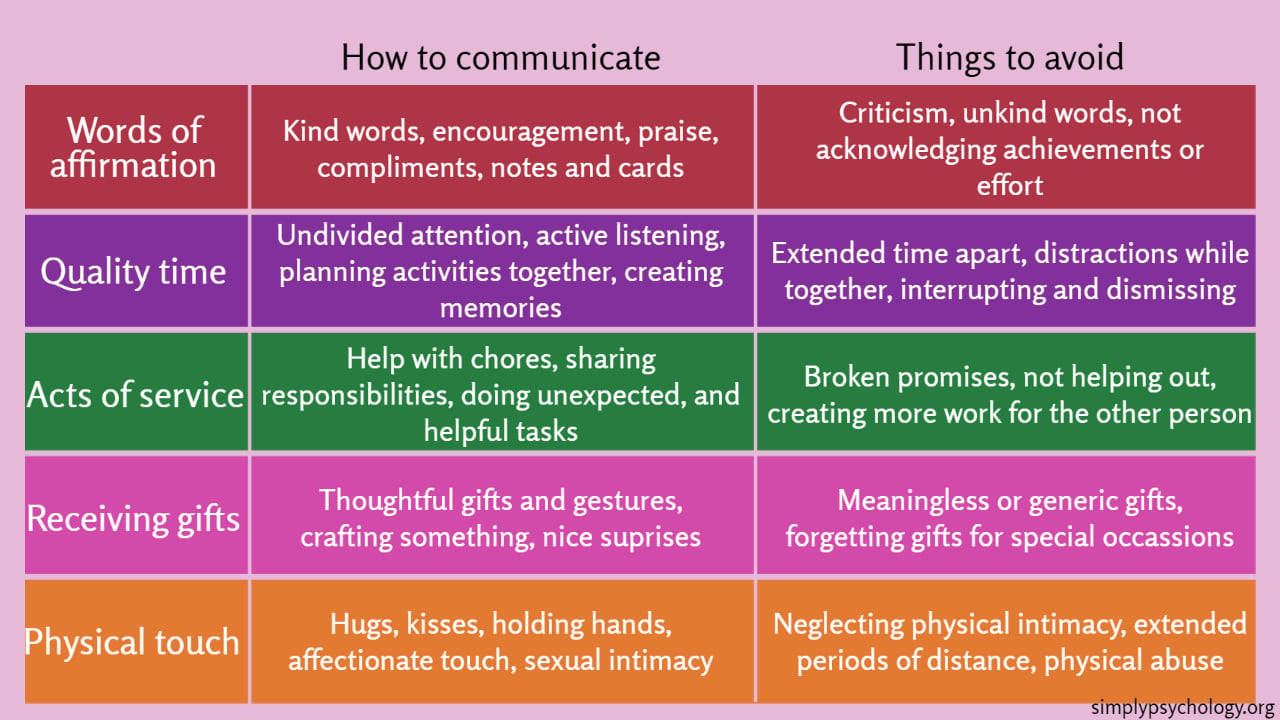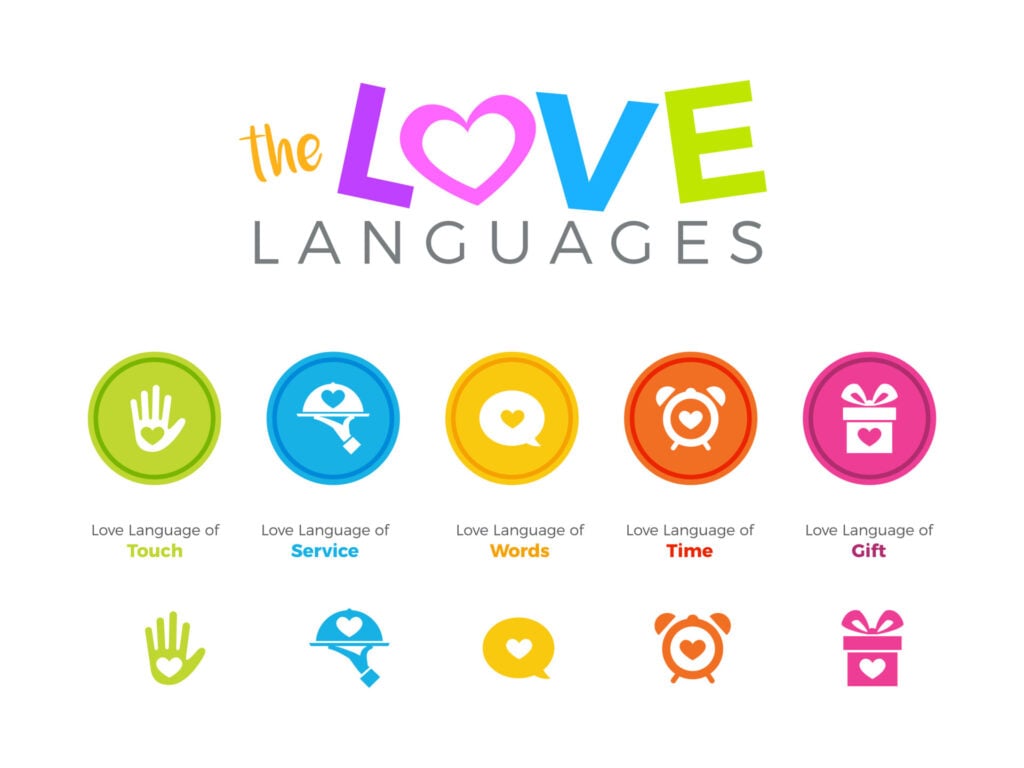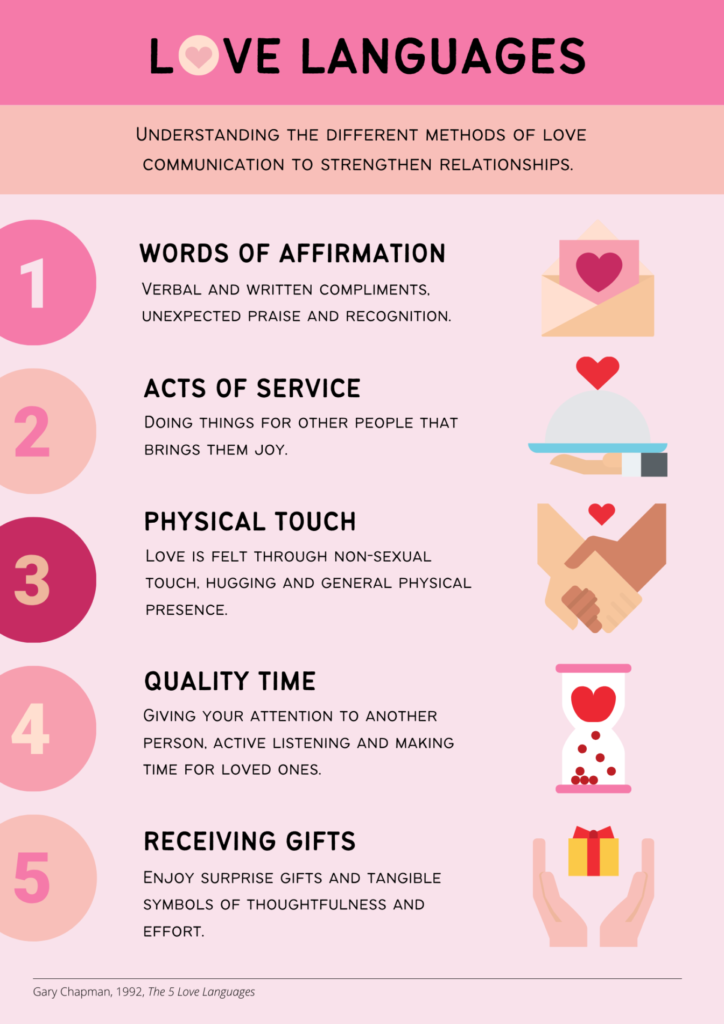On This Page:
The 5 Love Languages, developed by Dr. Gary Chapman, describe how people express and receive love: Words of Affirmation, Acts of Service, Receiving Gifts, Quality Time, and Physical Touch.
Understanding one’s primary love language can help enhance relationships by ensuring partners communicate love in a manner that’s most meaningful to each other.
If you want her to feel love, you’ve got to speak love in her language. If you want him to feel loved, you’ve got to speak love in his language.
Dr. Gary Chapman on The Five Love Languages:

Words of Affirmation
Someone whose love language is words of affirmation prefers love to be expressed through spoken words, praise, or appreciation.
They enjoy kind words and encouragement, uplifting quotes, love notes left by their partner, or appreciative text messages.
Pet names or special names used by couples in intimate relationships exemplify the “Words of Affirmation” love language. These endearing terms often stem from cherished moments or experiences, serving as vocal affirmations of affection and fondness, thereby reinforcing the emotional bond between partners.
People who prefer this love language may feel negatively affected by unkind words and may be overly sensitive to criticism from their partner.
A partner of someone who prefers words of affirmation may consider giving compliments, showing an interest shown in something their partner is talking about, and reacting positively to something their partner has accomplished.
They may say ‘I love you,’ ‘I’m proud of you,’ and ‘I appreciate you’ to connect with their partner on a deeper level.
Quality Time
If someone’s love language is quality time, they really appreciate love and affection being expressed through undivided attention from their partner.
This is not just being in close proximity to their partner often, but the quality of the closeness.
This can include making eye contact, actively listening, staying present, and focusing on partners. This can also include quality conversations such as sharing thoughts, experiences, feelings, and desires in a deeply personal, welcoming, and uninterrupted context.
If a partner of someone who has this love language is always on their phone during their time together, is condescending, interrupts, or dismisses their partner when they share their feelings, this can make their partner feel unloved.
Instead, being considerate and engaging in supportive listening will make them feel loved. Quality time can also involve couples engaging in activities or hobbies together that show enjoyment of each other’s company.
Dr. Gary Chapman offers the following advice to express love as quality time:
“Quality time for example, an old-fashioned handwritten letter speaks to the person who has quality time as their language because they’re sitting there reading it and they’re thinking, man they took time to write this thing. And then again, they can read it again and again and hold it in their hand. So that really does speak to quality time people.”
Physical Touch
Those whose primary love language is physical touch feel the most love and appreciation through physical affection.
This does not just have to be sexual intimacy but can include holding hands, hugs, arm and face touches, and putting an arm around your partner in public or when at home, such as when watching a movie together.
Physical touch can communicate comfort to a partner who is upset and happiness or praise when a partner is celebrating.
Simply put, people who prefer physical touch want to feel emotionally connected to their partner physically, and it may be important for them to feel physically close to their partner every day.
Long-distance couples out can also portray quality time and physical touch. Dr. Gary Chapman offers the following examples when a member of a couple is undertaking military service:
“Physical touch, you would think that would be impossible half a world away.
Well, one lady said this: I knew my husband’s love language was physical touch, so when he was deployed, I put my hand on a sheet of paper, I traced my hand, and mailed it to him with a note that said put your hand on my hand, I want to hold your hand.
When he came home, he said to me, every time I put my hand on that paper, I felt her. It’s not literal touch, but it’s emotional touch, and that’s what we’re talking about.”
“A man said, I knew her love language is physical touch so before I left I said to her, I’m gonna leave my jean jacket here, any time you need a hug, you put it on and I’ll hug you.
She said, every time I put it on I felt his arms around me. So there are practical ways that we spell those out in that military edition.”
Acts of Service
If someone’s primary love language is acts of service, they may want love expressed to them through their partner helping them out through helpful deeds.
This can include their partner doing unexpected, nice things for their partner, working on special projects together, completing chores, and helping with errands.
These usually take the form of the partner doing more than their normal share of responsibilities to relieve pressure or stress from their partner. People with this love language may really appreciate when their partner does something which they may not particularly enjoy just to make their partner’s life easier.
Laziness, broken commitments, and making more work for their partner may communicate to their partner that their feelings do not matter.
Doing nice and helpful things instead of just talking about doing them can communicate a deeper level of love to their partner.
Receiving Gifts
The final love language is receiving gifts. Those with this as their primary love language do not necessarily expect large or expensive gifts but appreciate the thought behind them. If a partner goes out of their way to get them a gift during the course of their day, this communicates to their partner that they were thinking about them.
These can also be gifts of no monetary value, such as finding a beautiful shell on a beach that a partner keeps to give their partner.
People with this love language treasure not only the gift itself but also the time and effort the gift giver put into getting the gift. Gifts could be physical items or even the gift of the partner themselves, such as going to surprise them when they do not expect it.
Partners who appreciate receiving gifts may find they remember every gift they have received because they made such an impact on them.
Someone with this love language may feel hurt if their partner never brings them meaningful gifts or forgets to give them a gift on special occasions such as birthdays and anniversaries.
What is My Love Language?
The five love languages are different ways that people express and experience love. Understanding your primary love language can enhance communication, deepen emotional connection, and foster a greater sense of intimacy in your relationships.
Ready to discover your love language? Let’s get started!
Words Of Affirmation
- Do you feel loved when someone compliments you or appreciates something you’ve done?
- How do you react when someone frequently says “I love you” or expresses their feelings towards you in words?
- Do verbal expressions of gratitude make you feel valued and respected?
- Do you feel most connected to your partner when they express their feelings for you verbally?
- Does it make you feel special when your partner expresses their love for you with special names or terms of endearment?
- Do you find written notes, letters, or messages expressing love particularly touching?
Quality Time
- Do you feel most connected to your partner when they spend uninterrupted time with you?
- How important is it for you to share experiences, activities, or hobbies with your partner?
- Do you value deep, meaningful conversations with your partner?
- How does it affect you when your partner is physically present but seems mentally distracted?
- Does it hurt you more when your partner cancels plans or doesn’t spend time with you compared to other disappointments?
Physical Touch
- Do you feel more loved when your partner expresses affection through physical touch, such as holding hands or hugging?
- How important is physical intimacy to you in a relationship?
- Do you feel more connected to your partner when they casually touch you, like a hand on your shoulder or a brush of your arm?
- Is your first instinct to physically comfort your partner when they are upset?
- Does a lack of physical touch make you feel distant or unloved?
- Does physical closeness, like sitting next to each other or cuddling, make you feel loved?
Acts Of Service
- Does your partner assisting you with your responsibilities make you feel cared for?
- How important is it for you that your partner steps in to lighten your workload when you’re overwhelmed?
- How do you feel when your partner goes out of their way to do something that makes your day run more smoothly?
- Would you feel more loved if your partner cooked your favorite meal or cleaned up without being asked?
- Does it upset you more when your partner doesn’t follow through with something they said they would do, compared to other disappointments?
- Do you often express love by doing things for others that you know they would appreciate?
Receiving Gifts
- Do you feel loved when you receive a gift that shows your partner was thinking of you?
- How important is it for you to receive tangible symbols of love from your partner?
- Does receiving a gift, regardless of its cost, make you feel appreciated and valued?
- How do you feel when your partner remembers special occasions with a thoughtful gift?
- Does the thought and effort behind a gift matter more to you than the gift itself?
- Does it hurt you more when your partner forgets to get you a gift for a special occasion compared to other oversights?
- Do you feel more loved when your partner surprises you with a small gift for no particular reason?
- Do you still keep and cherish gifts given to you by your partner a long time ago?
Love Languages in Relationships
Chapman concluded that people don’t give and receive love in the same ways and that everyone has a primary love language that speaks to them most deeply.
He found that patterns emerged in what his clients wanted from their partners. Five consistent patterns were found, which then became what he termed the 5 Love Languages.

Essentially, Chapman found that his client’s partners may have been expressing love, but it was not in a meaningful way to their partners. They may instead have been receiving an expression of love that is not connected to their love language.
By finding out people’s love languages and the love language of their partner, Chapman suggests that this can help people ensure that they both truly feel loved.
Chapman explains that falling in love is a ‘temporary emotional high’ and that after the initial emotional obsession has died down, partners must put in the effort to pursue what he terms ‘real love.’
He stated that after time in a relationship, couples might forget how to have meaningful connections with their partners. However, through understanding and practicing their partner’s love language, they can rectify and revive these relationships.
All five love languages are equally important, but people differ on the ones they prefer. Some people may appreciate all five, while others may actively dislike one or more.
Chapman suggested several methods in his 1992 book for discovering people’s love languages. He developed the Five Love Languages Profile, which is an online scale (found here)
Alternatively, individuals can ask themselves some of the following questions:
- ‘What does your partner do or not do that hurts deeply?’
- ‘What have you requested that your partner do more often?’
- ‘How do you regularly express love to your partner?’
- ‘What would your ideal partner be like?’
These types of questions allow people to see what is important to them and to pinpoint the desired ways they wish to receive love.
Although Chapman’s book was written in 1992, it has continued to help couples today.
How Love Languages Help Relationships
Promotes empathy and selflessness
Using and being committed to understanding another’s love language encourages people to learn to focus on their partner’s needs rather than their own.
Selflessness can be promoted through knowing a person’s love language via time, effort, understanding, and emotional openness. This also encourages partners to step outside themselves and look at what makes another person feel significant.
Being able to view things from someone else’s perspective can promote empathy. If people can empathize with their partner, then they are likely to understand another’s love language and why their partners’ may be different from their own.
Creating empathy for another person can also increase emotional intelligence.
Emotionally intelligent people often put others’ needs before their own, as well as being considerate of others’ perspectives, experiences, and emotions.
Creates more meaningful actions
When couples start to understand and use each other’s love languages more often, the thing they do not only become more intentional but also more meaningful.
By focusing on actions that are known to be more valuable to their partner, time is not wasted on actions that their partner does not appreciate as much.
Encourages self-awareness
Becoming more knowledgeable about how their own and their partner’s love language works can promote self-awareness.
People can become more considerate about how they communicate with their partners, understand what they should or should not do, and make a conscious effort to improve their relationships.
Helps with personal growth
Personal growth can stem from someone being focused on something or someone outside of themselves. Being focused on someone else’s love language can force people to grow and change for the better, to the benefit of their relationship.
The five love languages can also encourage people to love others in ways that they may not have considered before or that are outside of their comfort zone.
Stronger relationships
Putting in time and effort and creating meaningful activities with a partner can strengthen relationships. As they learn more about each other, the intimacy levels, security levels, and happiness of couples should be increased.
Chapman used an analogy of ‘emotional love tanks’ to describe the levels of a couple’s relationships. He stated that low or empty love tanks could cause romantic withdrawal or falling out of love, harsh interactions, or inappropriate behaviors.
Couples with full love tanks, who speak in each other’s love languages, can deal with conflict and cope with their differences. Problems can arise when partners do not know their partner’s love languages or how to use them, so the love tank can empty over time.
However, understanding and learning to use each other’s love languages are necessary for filling the love tank and strengthening relationships.
Are The Love Languages Valid?
Chapman states that the five love languages are a universal construct that can be found in various countries.
Karandashev (2015) argues that love is indeed universal, but it can manifest differently according to different cultures.
For instance, physical touch, such as hugging, can express love in some cultures, but in others, it can be seen as a sexual expression.
Chapman’s theory was based on his own experiences as a counselor and lacked scientific rigor, especially as there is not much research on the five love languages.
One study by Egbert and Polk (2006) tested this validity on students. The results showed that the common love languages expressed by the students matched those of Chapman’s theory; this study is the first empirical support of the theory.
Likewise, Surijah and Septiarly (2016) aimed to validate the love languages theory. The five love languages scale seemed to show a promising reliability score, and there were found to be 17 items on the scale which were valid.
One study on love languages found that if someone perceived that their partner was using their preferred love language well, they had increased feelings of love and relationship satisfaction. This was the case for heterosexual and homosexual couples (Hughes & Camden, 2020).
The same researchers also found that women who perceived their partners were using their preferred love language well reported greater feelings of love compared to men’s perceptions.
This suggests that love languages may be more effective in improving romantic relationships from a woman’s perspective.
Some issues with the theory are that some people may misuse their love languages, becoming competitive with their partners. Some may keep track of how many actions they have completed for their partner’s love language compared to how many their partner has done, which can put more of a strain on the relationship.
This can also pressure couples if some want their partners to express their love language consistently. Love languages should also not be seen as the main cure for a deteriorating relationship.
This theory may not be able to fix other relationship problems that may exist, and some couples may need further relationship guidance from professionals. For instance, if a relationship is toxic, abusive, or includes gaslighting behaviors, using love languages on their own may not fix the issues.
Love languages should thus be seen as one tool of many to aid communication.
The original model of the love languages written in the 1990s was focused on heterosexual married couples, Chapman often using ‘husbands’ and ‘wives’ when describing the partners.
This can be frustrating for those in homosexual relationships who wish to learn about the theory but may feel excluded.
However, the tools can be used by anyone if they are willing to overlook the heteronormative nature of the theory, as Hughes and Camden (2020) in their research found that homosexual couples benefitted from the love languages as much as heterosexual couples.
Lastly, the original works often described situations and gave advice that adhered to outdated gender stereotypes.
In a 1995 article by Chapman, some quotes included: ‘Isn’t it sweet when every day your wife has the breakfast table set with scrumptious food so you can get a good meal before you go to work…’, and ‘How about sending him food for lunch, or buying her new pots for her kitchen?’.
These gender stereotypes can make it frustrating for women to read, and they may dismiss the theory altogether. It may be that updating the love languages and using more inclusive language would make the theory feel more applicable to the general population.
Taking the outdated views out of consideration, the updated love language rating scales do not appear to be gender specific and can be applicable to anyone in any type of relationship.
Frequently asked questions
Does my love language need to be the same as my partner’s to have a strong relationship?
It can be easier if your and your partner’s love language align since you are more likely to be aware of what your partner appreciates if it is similar to what you appreciate.
Despite this, having different love languages does not have to be an issue. As long as the preferred love language is communicated and each person has a good idea of how to show love to their partner, then it is as simple as that.
Issues may only arise if a partner refuses to show their partner’s preferred love language or is not willing to compromise. This can make their partner feel unloved and can break down a relationship over time.
Can love languages be used in other relationships?
Although the original theory discussed the use of love languages between romantic partners, it is possible to use love languages in other relationships: with friends, family members, and co-workers.
For example, if you know that your friend’s love language is words of affirmation, you can ensure you use this with them. You could say tell them ‘I’m so proud of you’, ‘I love spending time with you’, or ‘You’re such a good friend’.
You can even express love languages to yourself. For instance, if your primary love language is receiving gifts, you could treat yourself to something you have wanted for a while or have a day at the spa.
Overall, there are endless ways in which love languages can be expressed to all the people in your life.
Can someone have multiple preferred love languages?
It is very common for people to have a preference for more than one type of love language.
The types may even complement each other. For example, if someone’s love languages are quality time and physical touch, these may be easily accommodated together, for instance, by putting an arm around a partner while watching a movie.
It is also possible for our preferred love language to change over time. This is because our needs and wants constantly change, so the way we receive and show love can also change.
How is the triangular theory of love different from love languages?
The triangular theory provides a structural model of love’s components, while love languages focus on the methods of expressing and experiencing love.
The triangular theory’s structure gives a holistic view of love, allowing for the assessment of the depth and type of love someone might feel. It recognizes that love isn’t one-dimensional. For instance, a long-term couple might have strong intimacy and commitment, representing a deep emotional bond and dedication but might have reduced passion over time. Conversely, a new relationship might be characterized by intense passion but lacks the depth of intimacy or the long-term commitment, indicative of infatuation.
The concept of love languages offers a practical approach to understanding and improving interpersonal relationships. Knowing one’s own love language and that of their partner can significantly enhance the quality of the relationship.

References
Chapman, G. (1995). The five languages of love. Chicago: Northfield.
Chapman, G. D. (2015). The five love languages: The secret to love that lasts. Northfield Publishing.
Egbert, N., & Polk, D. (2006). Speaking the language of relational maintenance: A validity test of Chapman’s Five Love Languages. Communication Research Reports, 23(1), 19-26.
Hughes, J. L., & Camden, A. A. (2020). Using Chapman’s Five Love Languages Theory to Predict Love and Relationship Satisfaction. Psi Chi Journal of Psychological Research, 25.
Karandashev, V. (2015). A cultural perspective on romantic love. Online Readings in Psychology and Culture, 5(4), 2.
Surijah, E. A., & Septiarly, Y. L. (2016). Construct validation of five love languages. Anima Indonesian Psychological Journal, 31(2), 65-76.
What’s Your Love Language? https://www.5lovelanguages.com/quizzes/love-language/


